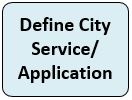Service and Information Alignment
|
Smart city architectures must support the connection between the service layer and the information layer to ensure that the needs of the citizens are satisfied by solutions provided by information technology (Anthopoulos 2015). The service layer defines components such as city services, domains, stakeholders, locations, etc., to support the smart city goals and to facilitate and optimize intelligent decision making (Pourzolfaghar & Helfert 2017)(Mohamed et al. 2017)(Hefnawy et al. 2016). The information layer defines components such as applications, software services and data, to support the automation or realization of city services (Singh et al. 2017)(Massana et al. 2017)(Rong et al. 2014). The service layer and information layer are physically and logically disconnected, making smart city architectures do not support the relationships across these architectural views. The identification of the architectural concepts and their relationships is essential to ensure an alignment between these layers. |
 |
The process to ensure the alignment between the service and information layers are defined as follows:
 |
 |
 |
 |
 |
 |
 |
 |
 |
 |
 |
 |
 |
 |
 |
 |
 |
Activities
- Specify involved City Service/Domain: Specify the different smart city domains (e.g. health, education, mobility, environment, tourism, etc.) of the current city service.
- Define Stakeholder/Data Entity: Define the required data entities for each stakeholder of the current city service.
- Define City Service/Data Entity: Define the data entities which are provided or consumed by the current city service.
- Define City Service/Application: Define the digital tools, monitoring applications, application modules, or another deployable component to support the current city service.
- Identify Software Service/Location: Capture the location where software services operate.
- Define Software Services/City Service: Define the required software services which support the current city service.
- Specify Software Service/Domain: Specify the domain to which the software services belong.
References
- Anthopoulos, L., 2015. Defining Smart City Architecture for Sustainability. In Electronic Government and Electronic Participation: Joint Proceedings of Ongoing Research and Projects of IFIP WG 8.5 EGOV and ePart 2015. pp. 140–47.
- Hefnawy, A., Bouras, A. & Cherifi, C., 2016. IoT for Smart City Services. In Proceedings of the International Conference on Internet of things and Cloud Computing. p. 55. Available at: http://dl.acm.org/citation.cfm?doid=2896387.2896440.
- Massana, J. et al., 2017. Identifying services for short-term load forecasting using data driven models in a Smart City platform. Sustainable Cities and Society, 28, pp.108–117.
- Mohamed, N. et al., 2017. SmartCityWare: A service-oriented middleware for cloud and fog enabled smart city services. IEEE Access, 5, pp.17576–17588.
- Pourzolfaghar, Z. and Helfert, M., 2017. Taxonomy of smart elements for designing effective services.In proceeding of 23rd Americas Conference on Information Systems (AMCIS 2017)
- Singh, P.M., Van Sinderen, M. & Wieringa, R., 2017. Reference Architecture for Integration Platforms. 2017 IEEE 21st International Enterprise Distributed Object Computing Conference (EDOC), pp.113–122. Available at: http://ieeexplore.ieee.org/document/8089870/.
- Rong, W. et al., 2014. Smart city architecture: A technology guide for implementation and design challenges. China Communications, 11(3), pp.56–69.